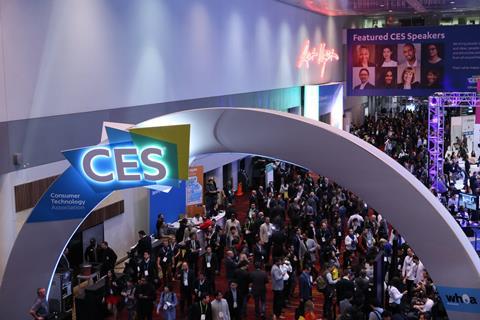The top gadgets, trends and experiences showcased at CES 2018 last week.
The Consumer Electronics Show hosted over 170,000 visitors, representing 3,900 companies from more than 150 countries in Las Vegas. The unusual and innovative technology ranged from driverless cars, the impact of 5G was explored and voice activation was present on a bewildering array of devices.
Here are the top 10 highlights:
1. LG’s OLED Canyon – In 2017 they offered a stunning canopy tunnel of curved OLED screens that left audiences in awe. This year, LG again exceeded expectations with its stunning OLED Canyon display. The curved screens wrapped around and loomed over heads seamlessly, creating a luminous pathway, transporting crowds from the Las Vegas Convention Centre into a lush green forest and sunset over rigid red canyons. The display captured the power of OLED and curved screens to make truly immersive, imaginative environments.
2. Ultrahaptics + Meta + Zerolight Collaboration - The Meta 2 augmented reality headset is lighter than the Hololens, and offers sharp and clear 3D images. Combined with Zerolight’s software and Ultrahaptics’ virtual touch technology, the experience offered users the chance to customise their future car while feeling holograms of colours, shapes, and the engine, making getting to know the potential of a car more engaging than ever before. It provided a glimpse into the future of retail.
3. Variety’s Entertainment Summit – Industry leaders from NBC Universal, YouTube, Disney, Twitter, and Fox shared their insights into the future of TV, branded content, and customer engagement. One of the biggest disruptions to the industry is the 400 hours worth of user content uploaded per minute onto YouTube. The result of this new era of entertainment means a shift towards demand for niche content, available anytime, anywhere, on any device, feeding algorithms for recommendations that keep the average YouTube viewer on the site for over sixty minutes and change the way we view and consider content.

4. HTC Vive Pro – One of the biggest reveals at this year’s show was the HTC Vive Pro, which sets new standards for virtual reality. The display offers greater pixel density with 78% more pixels and a 2,880 × 1,600 resolution (1,440 × 1,600 per display), making it the clearest resolution on the market. The headset is also notably more comfortable and less bulky, and they have added an additional camera for a wider field of view and 3D vision.
5. Time Travel – Two start-ups captivated attention with their claims of time travel. Timescope, a stand-alone virtual or mixed reality unit that can be used indoors or outdoors can offer individuals views into past and future landscapes. Pitched as a ‘time machine’, The Roader is a wearable camera that ‘allows users to record events that have already happened’. It records passively, and then when asked to record, it retains the previous 10 seconds captured, catching moments that otherwise would have been missed.
6. Google Assistant – While they haven’t made much effort with CES in the past, this year Google’s presence could not be ignored. They are keen to rival and overtake Amazon with Google Assistant, their voice controlled smart speaker. Announcing partnerships with Toyota cars, Vuzix smart glasses, and Kohler smart toilets, this is a good indication of a future where most interfaces will become voice activated.
7. Robots – Three robots stole the show this year. Omron’s ping-pong playing robot adapts to each opponent’s capabilities, though fails to pick up missed balls, while ITRI’ Scrabble-playing robot uses AI, 3D vision, and hand-eye coordination to crush their competition with vocabulary. Maybe the most buzzed about robot though was really more like an animatronic art installation, located off site at Sapphire Las Vegas. Nicknamed ‘R2DoubleD’, the robot stripper was ironically designed by British artist Giles Walker as “a protest about surveillance, power and voyeurism”.

8. Sports Zone Stage – Fans are demanding to know their favourite athletes as people, not just as players, and new technologies are making this possible. A leading example of an industry using innovation to their advantage to widen audiences and drive engagement, advances in e-textiles, bio-data, virtual and augmented reality, and e-sports could mean big shifts in revenue models, how many people attend events, and sports gambling. While progressive, this raises unanswered questions around player privacy and ownership of data.
9. Toyota e-Palette – The e-Palette is an innovative concept of an autonomous, electric vehicle by Toyota that can be customised to specific needs. With an open-control interface, purpose built interiors can serve different needs, from an on the road office, hotel room, or retail store, to parcel delivery and ride sharing. They also announced ‘The e-Palette Alliance’ between Toyota, Amazon, DiDi, Mazda, Pizza Hut, and Uber to develop a suite of connected mobility solutions, and coordinate strategies for smart-city planning and market entry.
10. Samsung’s The Wall - The world’s first consumer modular MicroLED television, ‘The Wall’, is 146-inches. Delivering incredible brightness, colour volume and black levels, it can be customised to fit any room. The adaptability is made possible because the MicroLED are smaller than LEDs and a self-sufficient light source. They also revealed a flexible 65” OLED screen that can ‘roll-up like a poster’, and the world’s first QLED TV featuring 8K AI technology, to be available later this year.
Honourable Mention:
11. Intel’s 5G Experience – Including an LED tunnel and immersive 360-degree autonomous vehicle driving simulation, these impressive installations demonstrate how 5G will change the future through greater, more reliable connectivity. From driverless vehicles, to connected homes, data will update and correlate in the cloud, offering benefits of seamlessness and safety. Intel plans to debut its 5G capabilities to the world at this year’s Winter Olympics.
Read more CES highlights: The impact of 5G, audience engagement and AI personalisation
























No comments yet